Poster session Scaling-up Nature-based Solutions in Latin America
We present the posters developed by our Coastal Solutions Fellows to summarise some of the amazing work they have been doing throughout the Pacific Coast of Latin America to create coastal resiliency and protect shorebird habitat across the Pacific Flyway. These posters were presented during our Special Event “Scaling up Nature Based Solutions in Latin America” held at the Willard Straight Hall, Ithaca, NY, on Thursday 23rd February, 2023 alongside Adaptation Latin America and the Interamerican Bank of Development.
Session Scaling-up Nature-based Solutions in Latin America
You can take a look the presentations and panel discussion of our special event here:
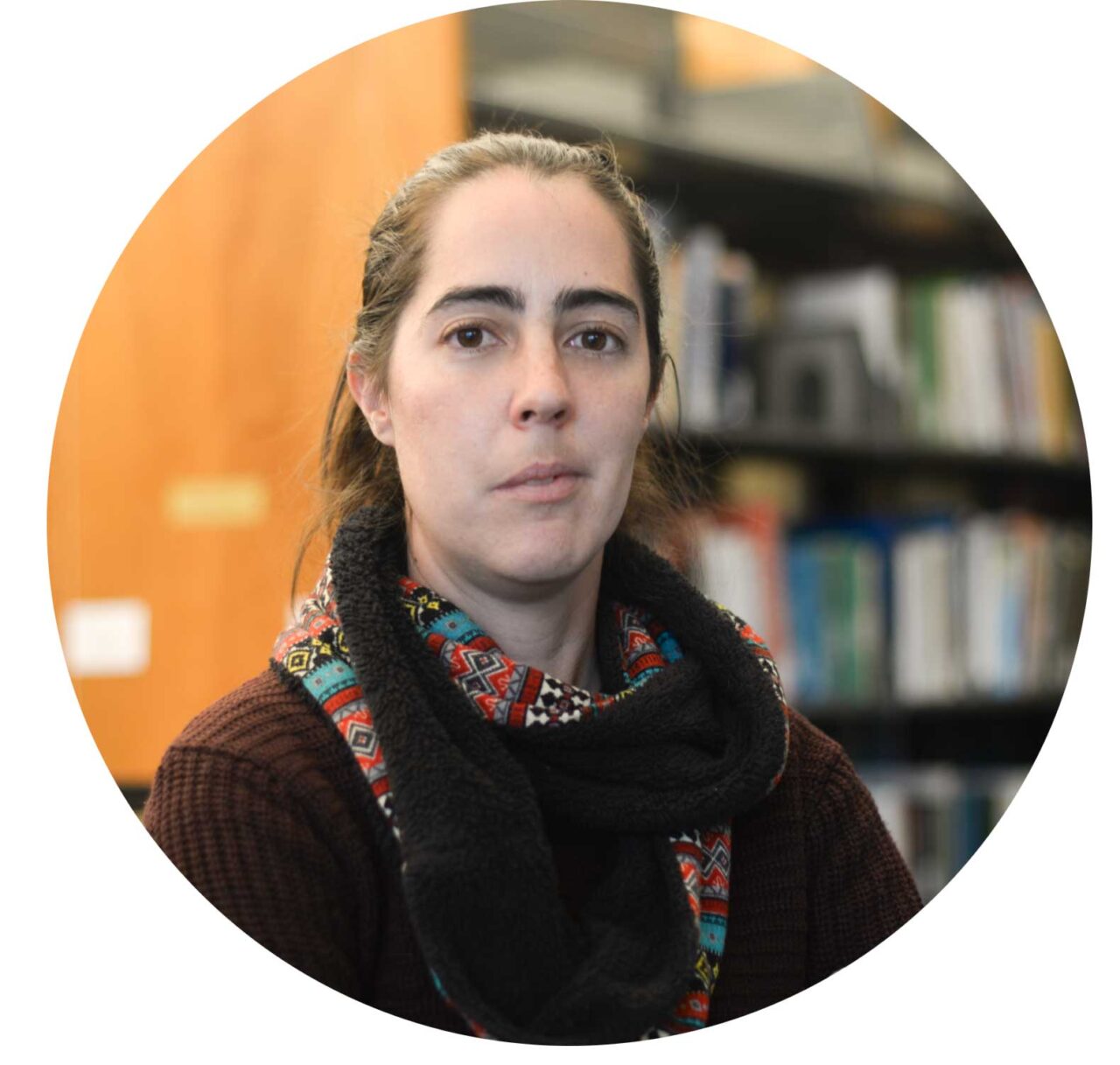
María Valladares
Fellow CSF 2023 / Chile
mv464@cornell.edu
Coquimbo Bay: Integrated Strategy for Conservation and Building of Coastal Resilience
Coquimbo Bay, in the central-northern zone of Chile, is considered an important area for the conservation of shorebirds. This area is classified as site 139 in the Pacific Americas Shorebird Conservation Strategy (PASCS), an Important Bird and Biodiversity Area (IBA) site and is being promoted for the Western Hemisphere Shorebird Reserve Network (WHSRN) designation. In the Bay, 33 species of shorebirds have been recorded, of which 12 correspond to focal species, 3 are considered “Near Threatened” and 2 species nest in this priority site. The La Serena-Coquimbo conurbation has experienced a large population increase and expansion in recent decades, placing it as the fourth urban entity in the country. Urbanization in the coastal area and an economic development approach that promotes sun-and-beach tourism have resulted in a degradation of the coast. Faced with this scenario, multiple protection initiatives promoted by various sectors have emerged, but lacking an articulated governance. This project seeks to promote the conservation and protection of the coastal ecosystems and shorebirds in Coquimbo Bay through an integrated conservation strategy with three strategic lines: strengthening of governance and stakeholders’ articulation; implementation of a monitoring citizen science program to support conservation decision-making; and development of shorebird conservation strategies and human wellbeing. These lines will allow for the development of an integrated management model for the coastal zone; a participatory management plan for El Culebrón wetland; capacity building through the implementation of the environmental and shorebird monitoring citizen science program; protection of American Oystercatcher nesting areas and environmental outreach. Dr. María José Martínez-Harms, an expert in conservation, landscape ecology and planning, will be the mentor, and the Institute of Public Policies of the Universidad Católica del Norte will fulfill the role of host institution. Several intersectoral collaborators from the public, private, academic and civil society sectors will participate in the project.
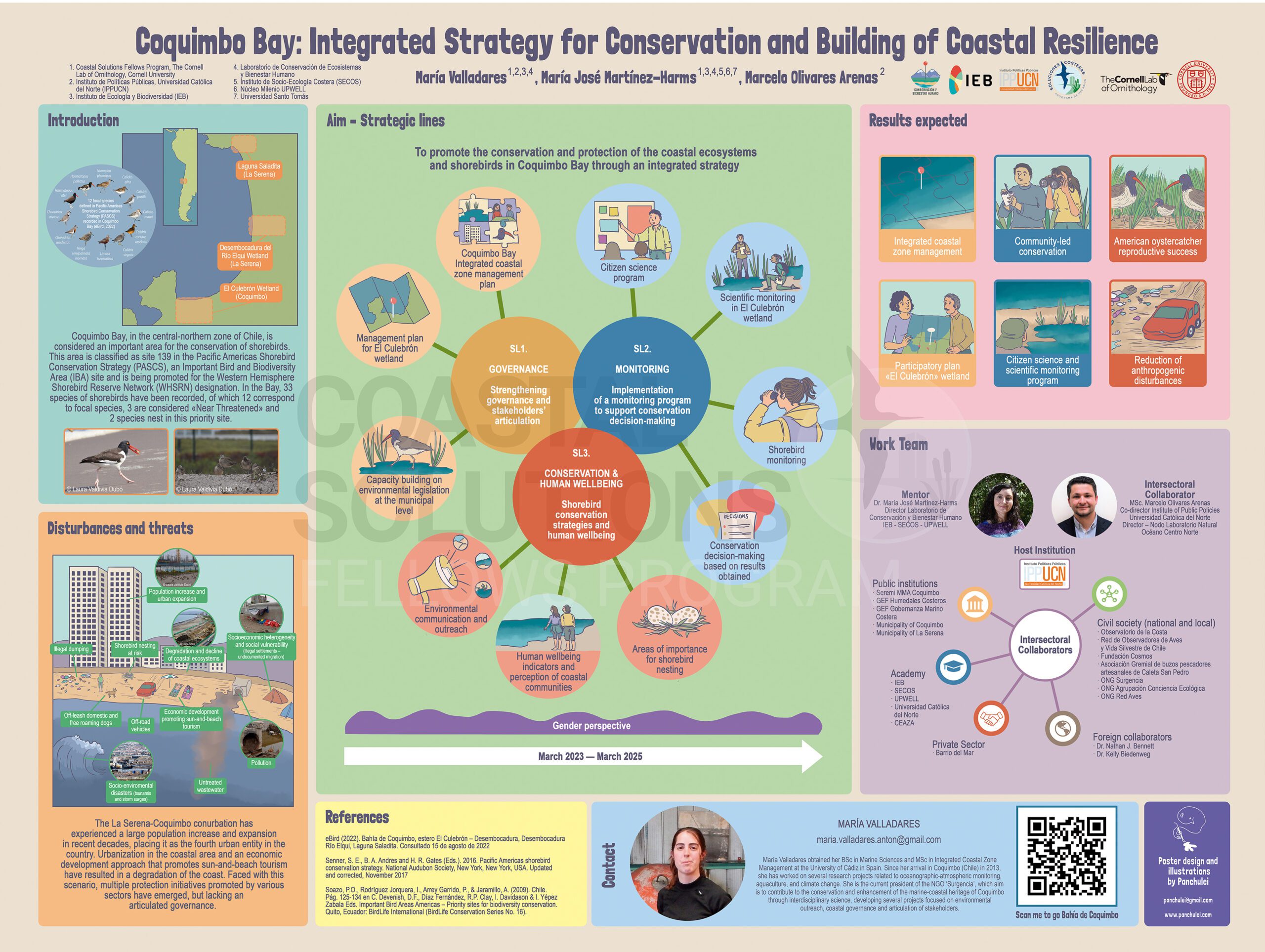

Ariadna Araúz Ponce
Fellow CSF 2021 / Panama
aia36@cornell.edu
Panama Bay Wetlands, Panama City.
Regenerative Master Plan for Juan Díaz and Don Bosco Area in Panama Bay
The Panama Bay Wetlands, mainly its first 30 km, are of hemispheric importance, on which 80% of the shorebirds of the Pacific Americas Flyway depend for resting and feeding during long-distance migration. However, the city’s urban footprint stretches here, generating a complex coexistence between humans and shorebirds. This shared space includes stakeholders from diverse socioeconomic realities motivated by different interests and aspirations that lead to the conflict, highlighting real estate development due to its strategic location and the perception of leftover space associated with the constant denial of the ecosystem services they offer. Therefore, the purpose of this project is to establish a model to reorient development —focused on water dynamics— to achieve climate adaptation and regenerate the inhabited soil of the bay drainage basin, through low-impact development solutions (LID) adoption. Applying behavioral insights, coastal adaptation strategies, and market-based mechanisms, this project aims to work beyond urban planning and legal instruments to insert a new flow of resources to (i) reach a cost-effective regeneration of critical ecosystems, vitally important for both humans and shorebirds, and (ii) demonstrate the possibility of working in a collaborative model to reach the site sustainability when the divergent motivations of stakeholders converge.
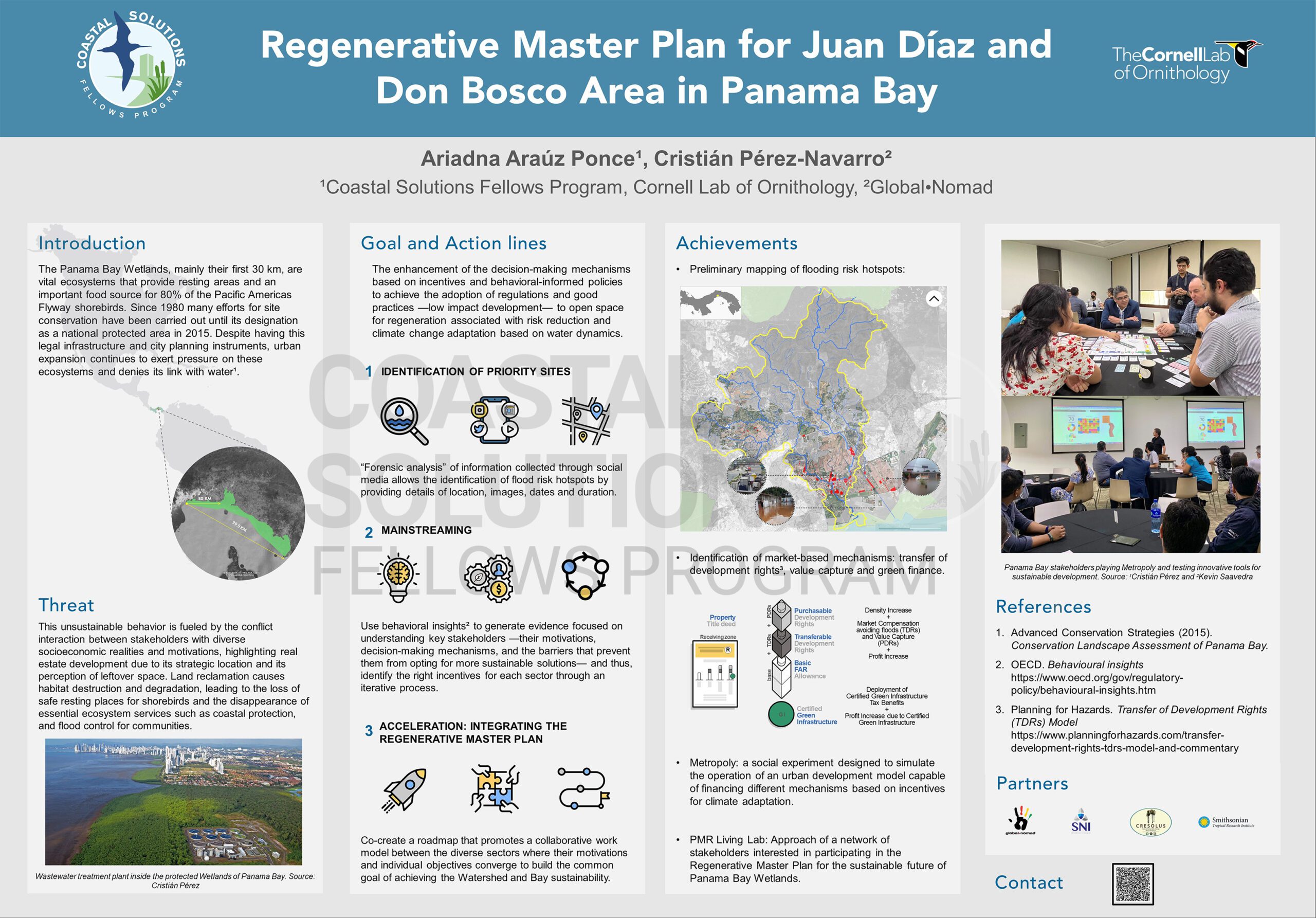
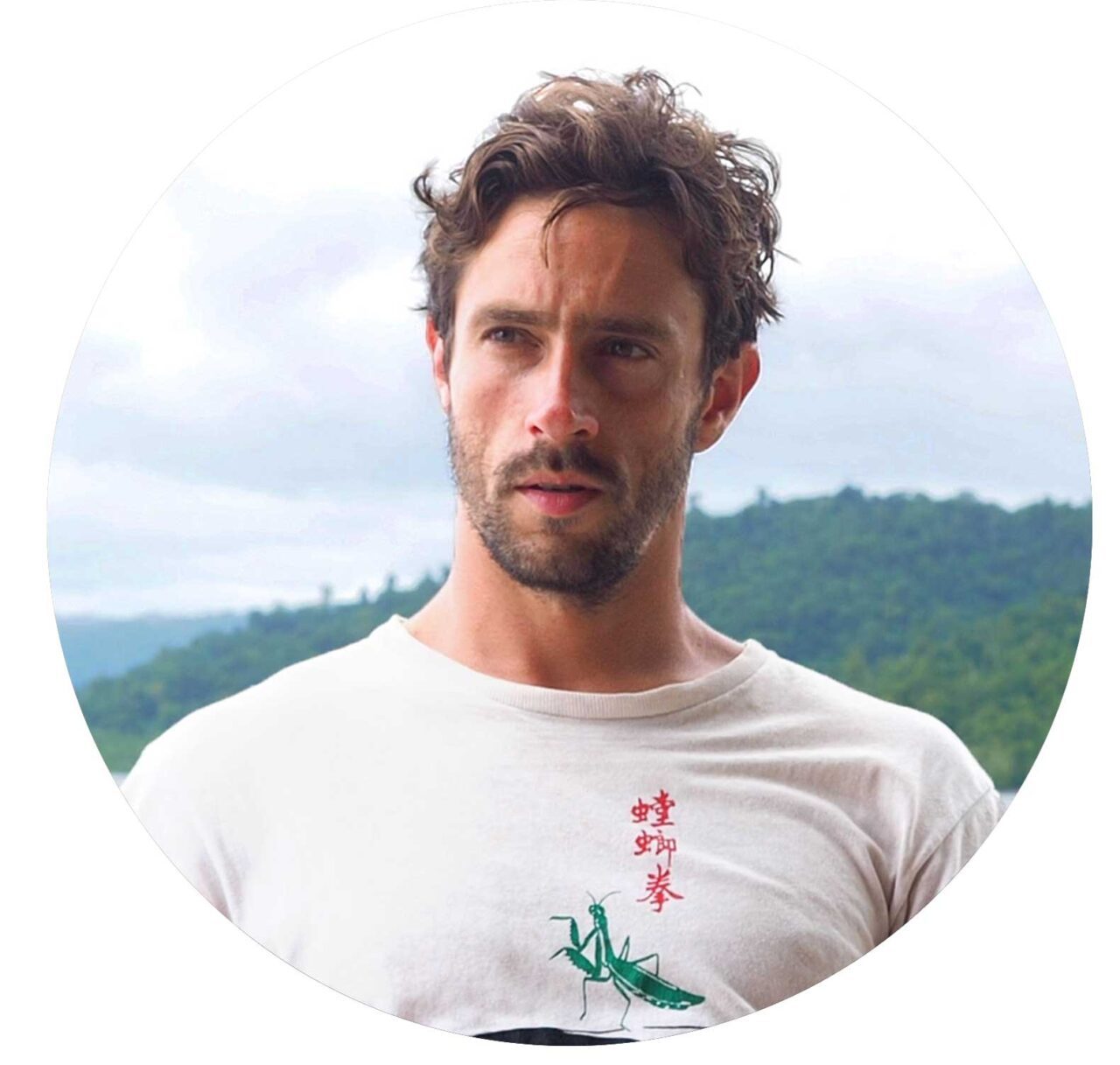
Juan Silva
Fellow CSF 2022 / Chile
jas977@cornell.edu
Building Resilience for Mataquito & Huenchullamí Coastal Wetlands in Maule Region, Chile
The Mataquito and Huenchullami coastal wetlands comprise more than 2,000 hectares and are internationally recognized for their importance for both resident and migratory shorebirds. This site is seriously threatened by human disturbances and pollution. From a socio-ecological perspective and with the use of participatory methodologies, this project seeks to articulate conservation professionals, government and local organizations around the co-construction of capacities for the conservation of shorebirds and the well-being of human communities in the site. Through the empowerment of key actors, co-learning and the promotion of governance, it is expected to institutionalize programs (birdwatching, environmental education and citizen science), monitoring systems, governance mechanisms, financing strategies, and explore official protection categories to reduce threats from human disturbances and pollution, and ensure the protection of the site in the long term.
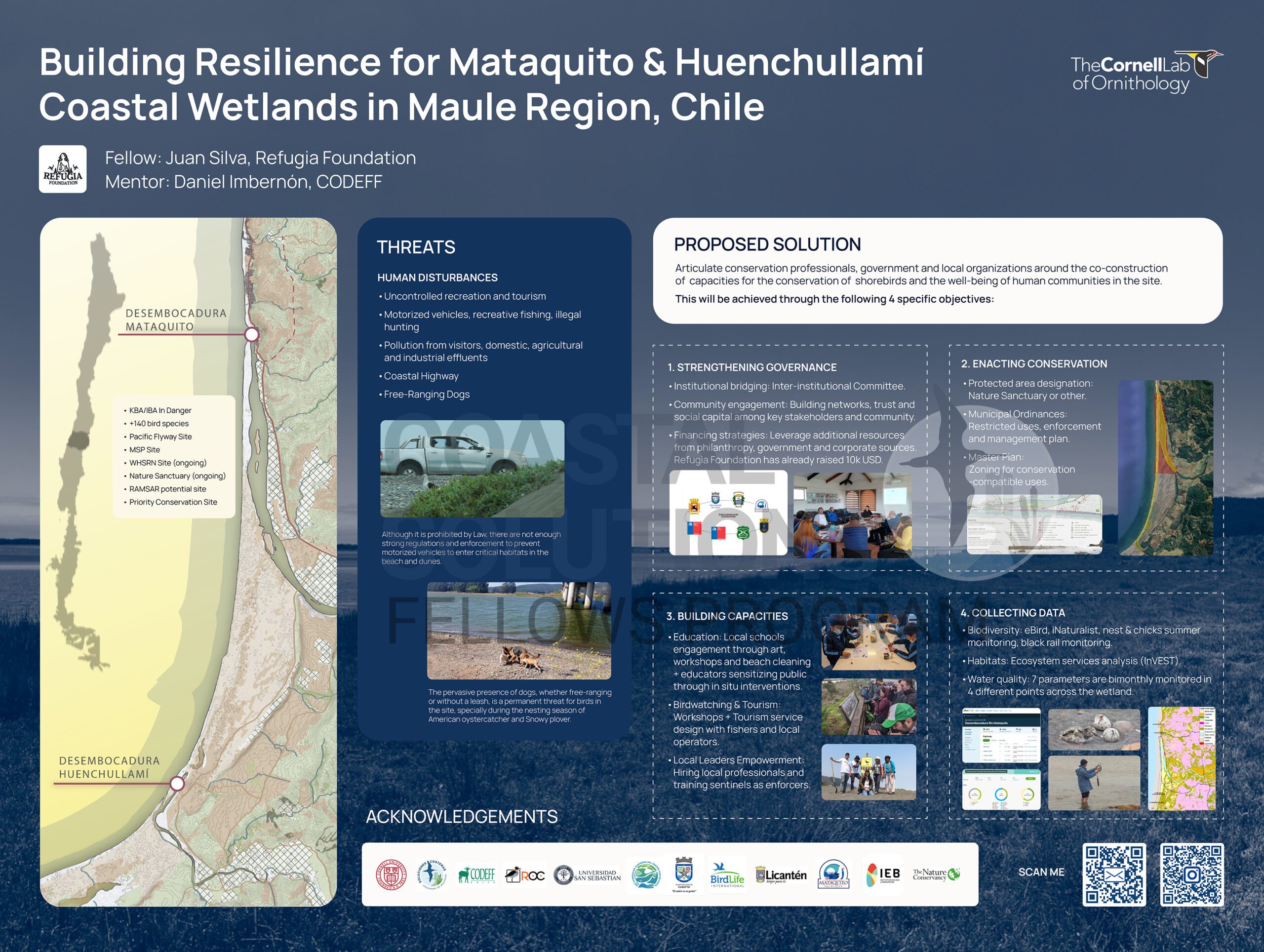

Juanita Fonseca
Fellow CSF 2021 / México
jf686@cornell.edu
Implementing shorebird-friendly management practices on shrimp farms in Mexico
Shrimp farms in northwestern Mexico dominate the coastal landscape, contributing to the loss of shorebird habitat. Currently, these productive systems are used by thousands of migratory shorebirds as feeding, resting, and even breeding sites for some species. If adequately managed, shrimp farms can be an integral part of the solution to supplement the loss of coastal wetlands. Therefore, this project promotes the implementation of shorebird-friendly management practices in shrimp farms in the Ensenada de Pabellones lagoon system, a site of international importance within the Western Hemisphere Shorebird Reserve Network, which hosts more than 300,000 shorebirds in the winter. During the shrimp harvest, water ingress into the ponds contributed to the increase in the feeding sites for 20 species of shorebirds for more than a week. The hydrodynamic model will contribute to water management in the harvested ponds, and we will be able to estimate how many hectares could provide foraging habitat for shorebirds. Monitoring during the breeding season highlighted the importance of these sites for five species, three of which are under some protection category in Mexico. The placement of nest signs contributed to the low loss of nests by roadkill and the hatching success of the eggs. Meetings with producers and workshops with farm personnel highlighted the importance of these sites for shorebirds, leading to an agreement to designate 4,000 hectares to implement monitoring, management, and conservation actions. Finally, we want to promote the interest of the aquaculture sector, which is why various activities are being developed simultaneously to promote certification of farmed shrimp, which improves the quality of these sites for shorebirds and benefits the producer.
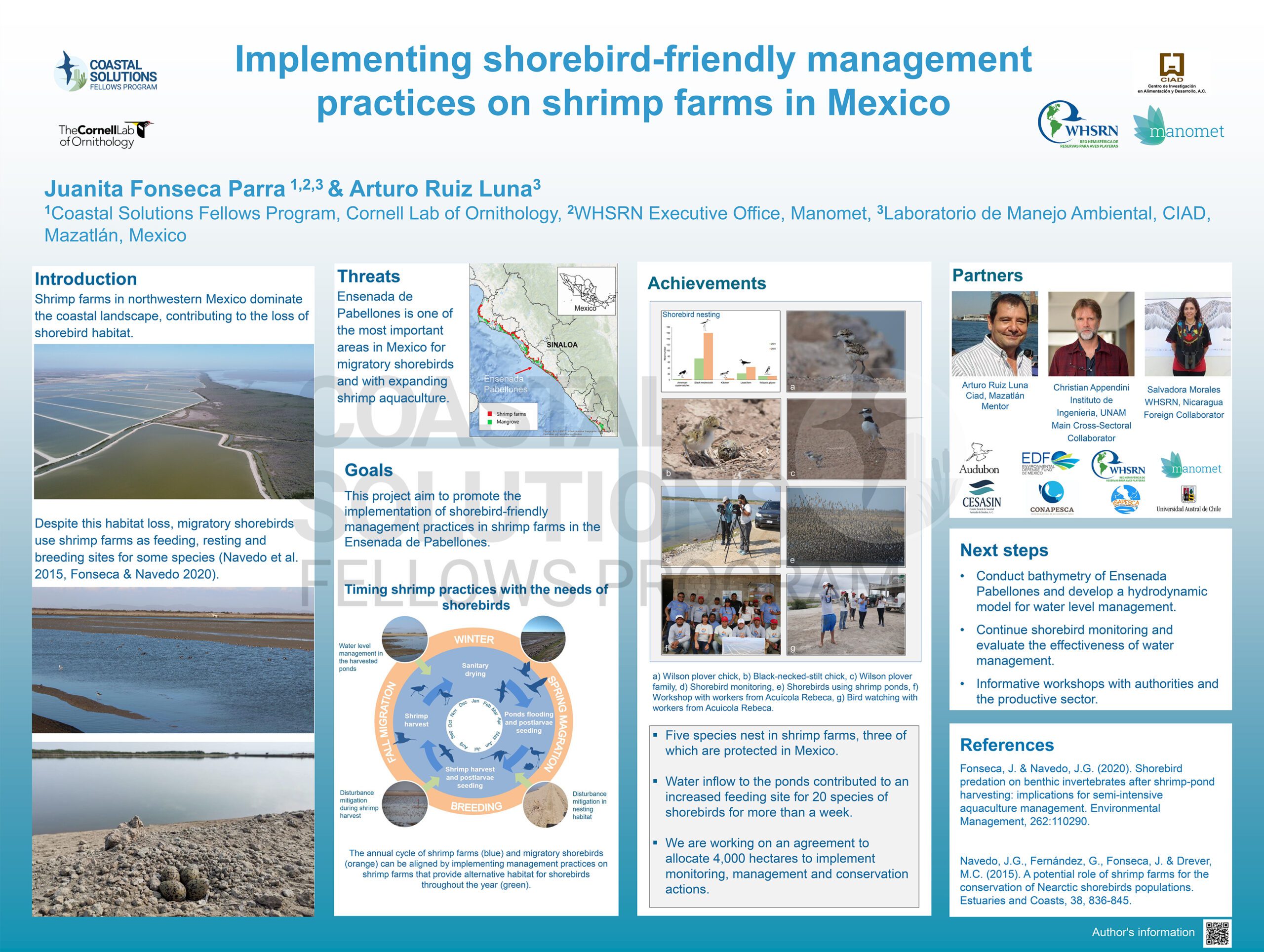

Eliana Montenegro
Fellow CSF 2021 / Ecuador
em663@cornell.edu
Solutions for a sustainable coexistence between people and aquatic birds in La Segua, Ecuador
La Segua wetland, located in the province of Manabí, has more than 1700 hectares that provide habitat for more than 126 species of resident and migratory birds. Despite being declared a wetland of international importance, it presents latent threats to its ecological integrity and biodiversity. The project “Solutions for Sustainable Coexistence between Humans and aquatic birds in La Segua, Ecuador”, supported by the Coastal Solutions Fellows Program of the Cornell University Lab of Ornithology, seeks to maintain the ecosystem functions of La Segua for the benefit of residents and migratory waterbird populations through the implementation of better production practices, systematic monitoring, and local capacity building. To date, the main achievements of the project include: 5 hectares of shrimp ponds intervened with landscape modifications, two shrimp ponds monitored in boreal migration months (October 2021 to February 2022), a native plant nursery for restoration activities, four workshops for local capacity building, monthly counts in four navigable routes covering the entire wetland, and one conservation easement signed with one shrimp farm owner to maintain habitat for migratory shorebirds in the next 20 years. The results showed that shrimp farms could be important habitats for migratory shorebirds such as Least Sandpipers, Semipalmated Sandpipers, Whimbrels, Greater Yellowlegs, and Lesser Yellowlegs, among others. The challenges are enormous. However, these results demonstrate that proper and sustainable management of shrimp farms could become effective actions and opportunities to conserve shorebirds throughout their migratory route in the Pacific.
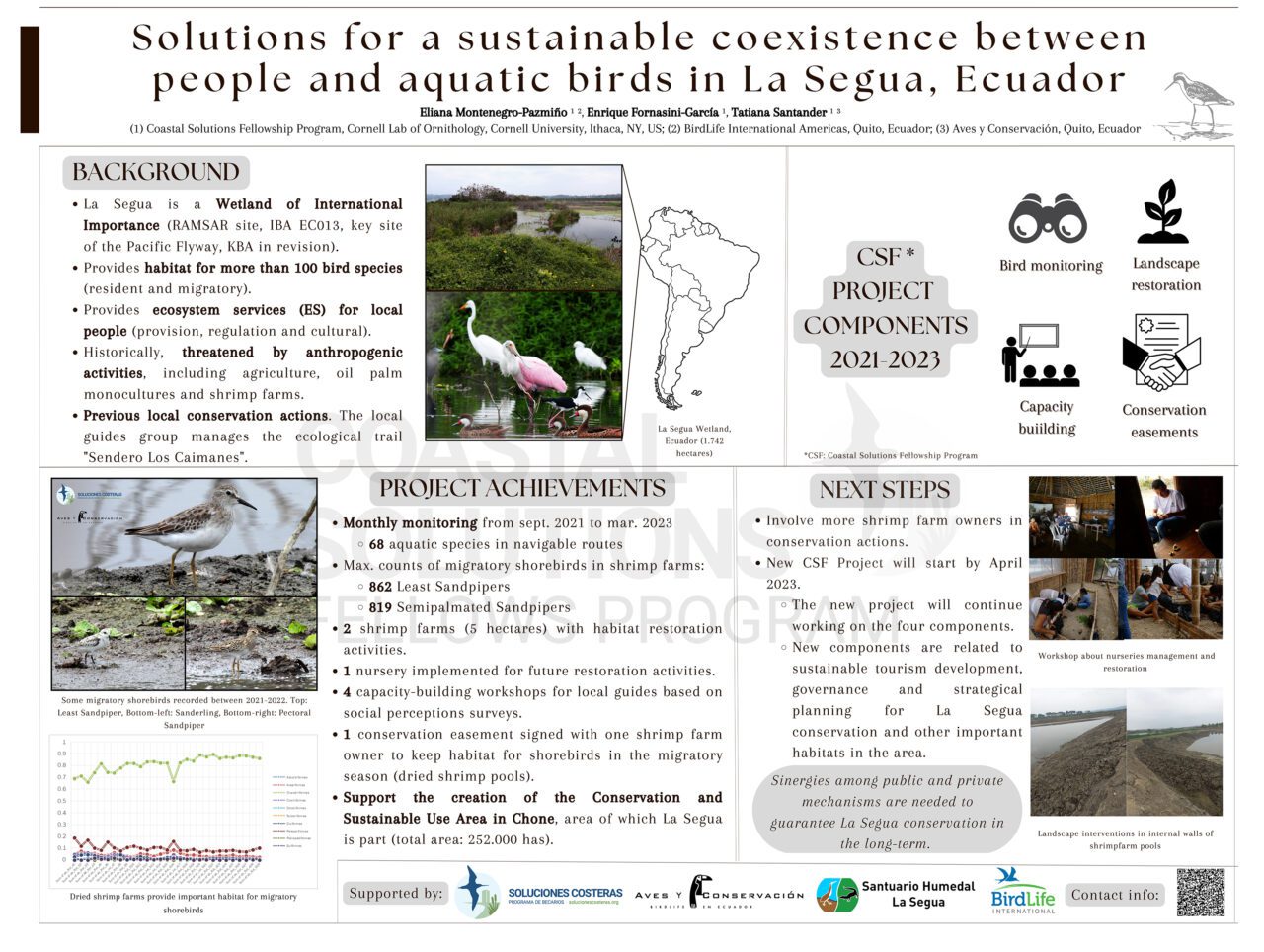

Ballantyne Puin Castaño
Fellow CSF 2023 / Colombia
bp373@cornell.edu
Territorial Center for Conservation: a community-scientific led tourism effort based on bioeconomy
Punta Soldado Island (PS) is a strategic place for the development of conservation strategies in the Colombian Pacific. PS Island has a regional priority category for the shorebirds’ conservation and their habitats within the American Pacific Migratory Route. Additionally, it is a place where relevant scientific developments have taken place, such as the discovery of the first observations of some migratory birds and their behavior. PS Island is part of the National Protective Forest Reserve of Anchicayá. However, the economic needs of the communities living there have caused unsustainable changes in land use driven by conventional tourism and impacting shorebird habitat. This situation led to the creation of a new alternative known as ‘The Territorial Center for Conservation’: a community-scientific led tourism effort based on bio-economy. This center seeks to transition from conventional tourism towards scientific and nature tourism, enhancing the conservation of shorebird habitat and economic support for the community. This project focuses on 3 points to consolidate the center: 1) strengthening local capacities, 2) consolidating a community enterprise and complementary financing strategies, and 3) a monitoring plan for the protection and maintenance of shorebird habitats. In the long term, this project will help structure the territorial center as an articulation between different sectors such as the community, academia, businesses, and the public sector.
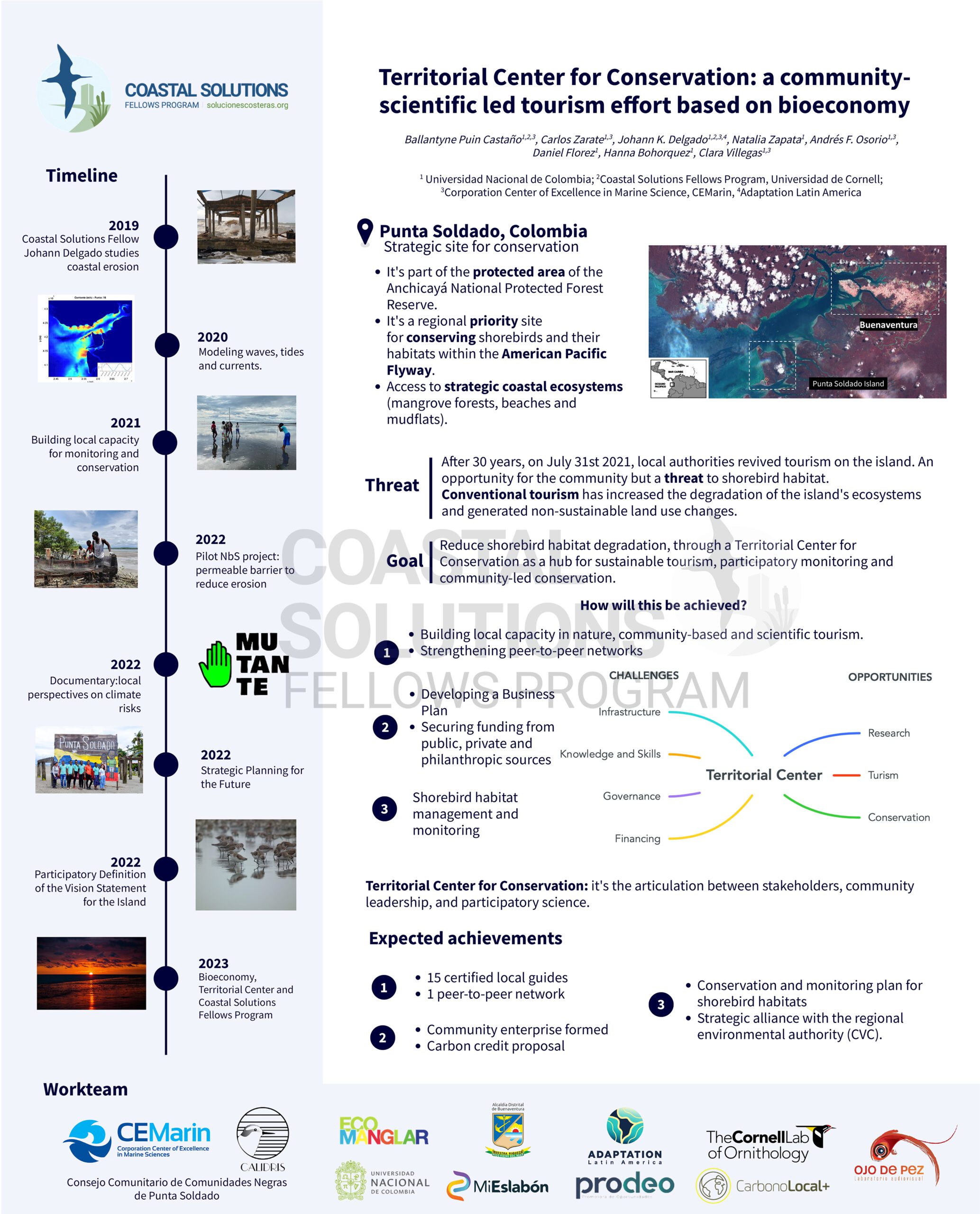

Onil Rodríguez
Fellow CSF 2023 / Honduras
gor7@cornell.edu
Habitat conservation initiatives in the reserve Punta Condega – Jicarito System: safe sites for shorebirds in Gulf of Fonseca, Honduras
The “Punta Condega – Jicarito System” located in the Gulf of Fonseca, Honduras. It is the unification of four Habitat Management Areas by Species (AMHE – for its acronym in Spanish) that includes 45,393 hectares and is an integral part of the Mesoamerican Biological Corridor “Pacific of Honduras”. It was recently named as part of the Western Hemisphere Network of Shorebird Reserve Network (WHSRN) as a reserve of regional importance for shorebirds. It is home to a diversity of habitats including sandy and gravel beaches, shrimp farms, and natural salt flats. The main threats that this project addresses are the loss of habitat due to inappropriate practices, as well as the absence of regulations or guidelines that do not allow communities to be encouraged into conservation issues and environmental education.Shorebird monitoring will also be implemented as an indicator of ecosystem health.The five solutions and products proposed are: I) a habitat conservation action plan supported, II) a manual of good practices in shrimp farming, III) the creation of legal regulations that allow access to economic incentives to motivate communities to participate in conservation initiatives, IV) a report of standardized annual monitoring to increase knowledge about shorebirds in Honduras, V) accompanied by an environmental education campaign.
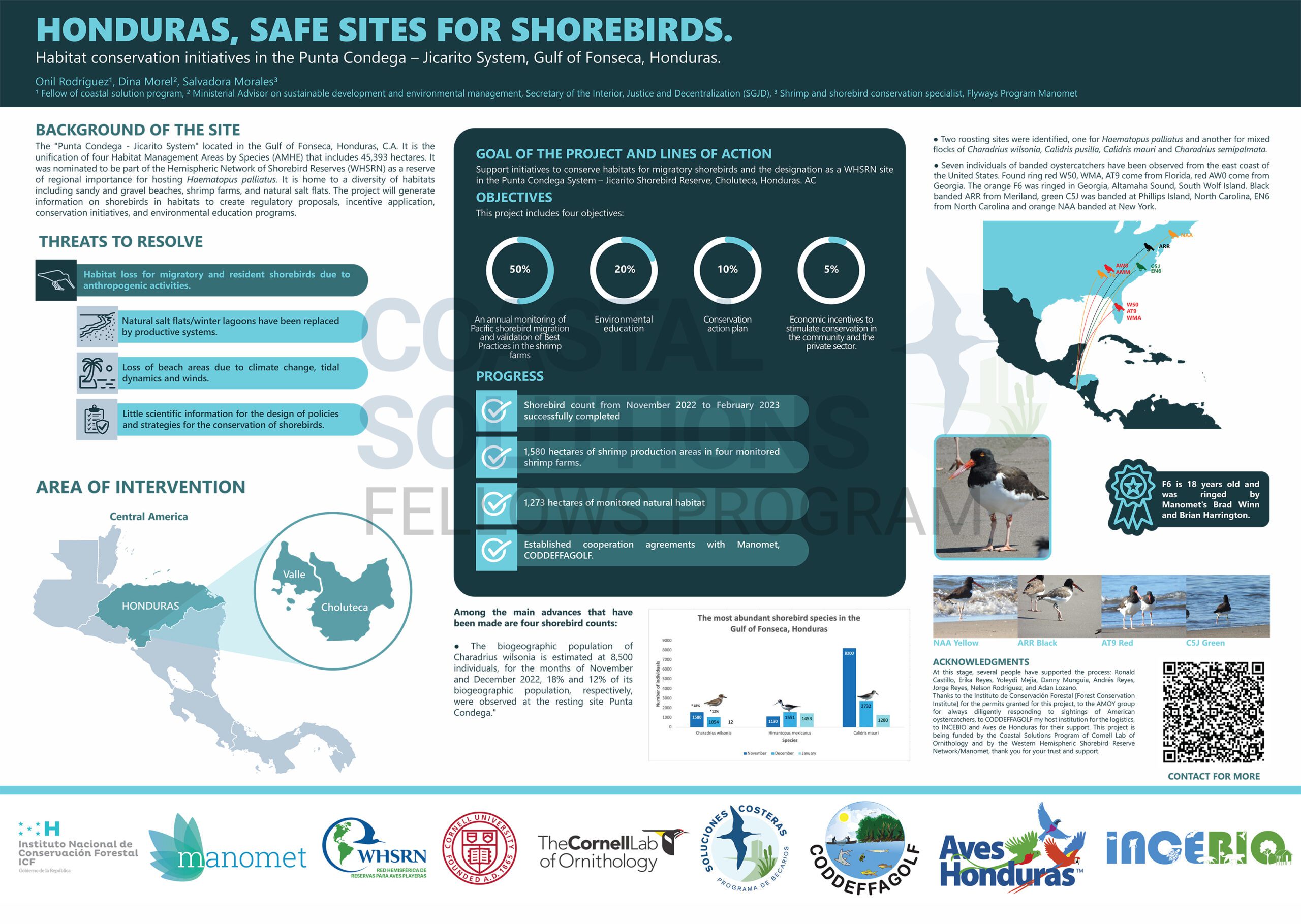

Gabriela Contreras
Fellow CSF 2022 / Chile
gic22@cornell.edu
Conservation through zoning and local involvement in the Coihuín Marine Wetland, Puerto Montt, Chile
The Coihuín marine wetland is located in southern Chile, in the Los Lagos Region. It is an intertidal wetland internationally known for hosting essential percentages of resident and migratory shorebirds (Whimbrel, Hudsonian Godwit, and American Oystercatcher), being part of the IBA, WHSRN, and the American Pacific Flyway sites. This site is currently in the process to be recognized as a Coastal Marine Space for Native People (ECMPO – for its acronym in spanish) by Huilliches Lafkenches indigenous communities. Still, to date, it does not have any official protection and presents several threats associated with urbanization. This locality represents an area of high population growth in the absence of land management plans, which is manifested through land subdivisions, illegal takeovers, irregular construction, pollution, the presence of free-living dogs, vehicle traffic in unauthorized areas, poor tourism and recreational practices. In this context, this project seeks to conserve shorebird habitats through integration and local participation in decision-making and the development of sustainable production practices with shorebirds and their habitats. We will employ strategic lines based on governance and articulation with key stakeholders, site management through planning and zoning, mechanisms to promote good production practices, and capacity building through education and empowerment of local groups. The main advances to date relate to i) identification of relevant stakeholders of the site and their historical habitat, ii) formation and capacity building of a group of local monitors, c) diagnosis of productive practices of shore collectors, and d) effective involvement in local educational centers.
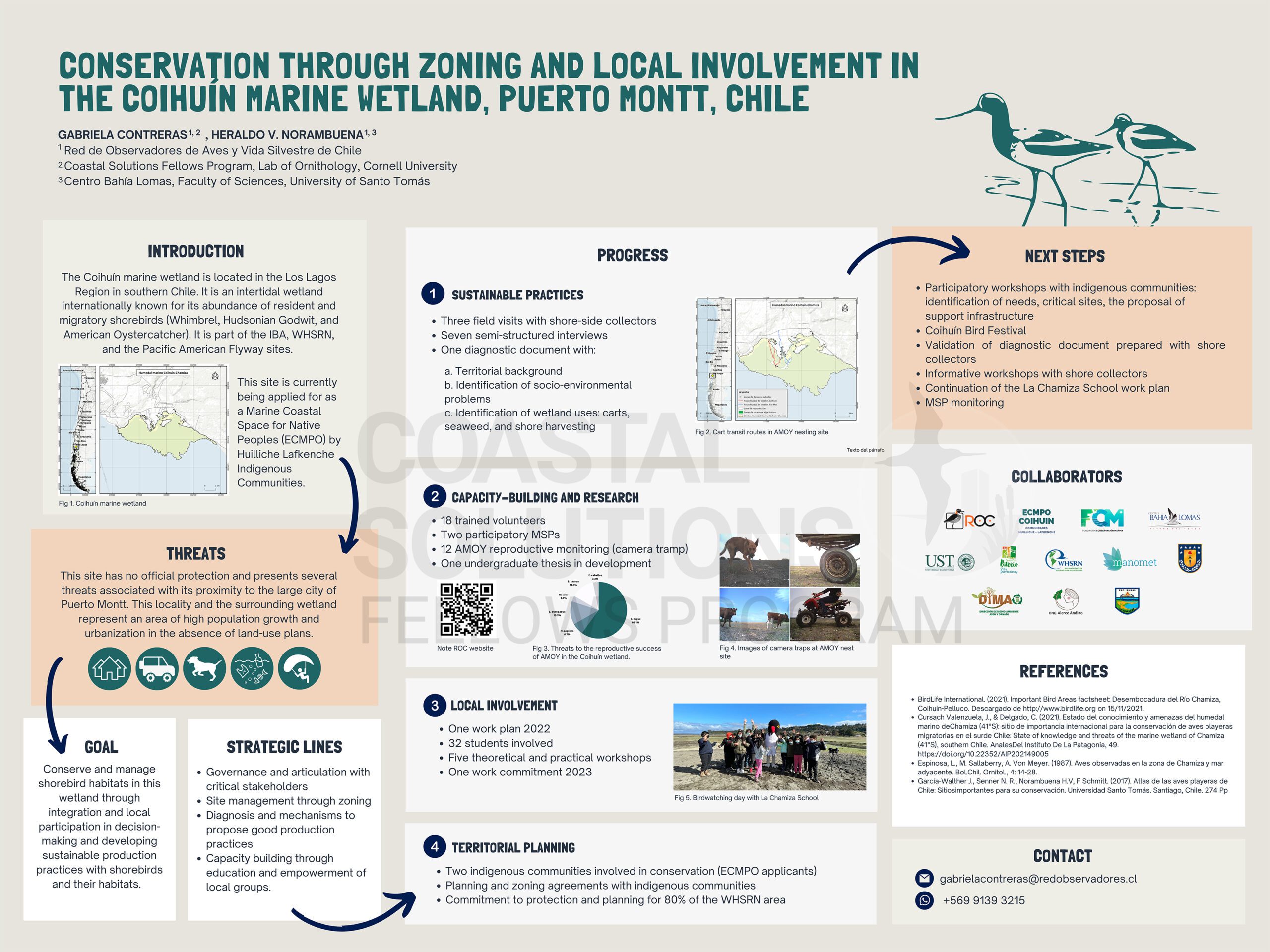

Varinia Sagastume
Fellow CSF 2020 / Guatemala
kvs54@cornell.edu
Participative strategies in the development of Best Management Practices for the shrimp industry in Guatemala
Thinking of the producer as an opportunity for conservation is an approach that allows us to understand beyond the impact of the shrimp industry. Through the application of best management practices (BMPs), we can collectively build solutions that integrate both the needs and interests of producers and those of shorebirds and their conservation.
We use the methodology of Open Standards for the Practice of Conservation to design strategic planning in a participatory manner that establishes actions within production practices to favor the availability and quality of habitat for shorebirds with potential benefits for producers and local communities. Through workshops, we implemented various participatory methodologies to understand the shrimp production system and identify threats and opportunities for the conservation of shorebirds. In addition, the purpose of planning is to inform, built capacity and involve key stakeholders in making conscious decisions within their production process.
These strategies allow us to design and monitor BMPs that will be used to support informed decision-making and improve the practice and effectiveness of conservation actions in the Guatemalan shrimp industry.
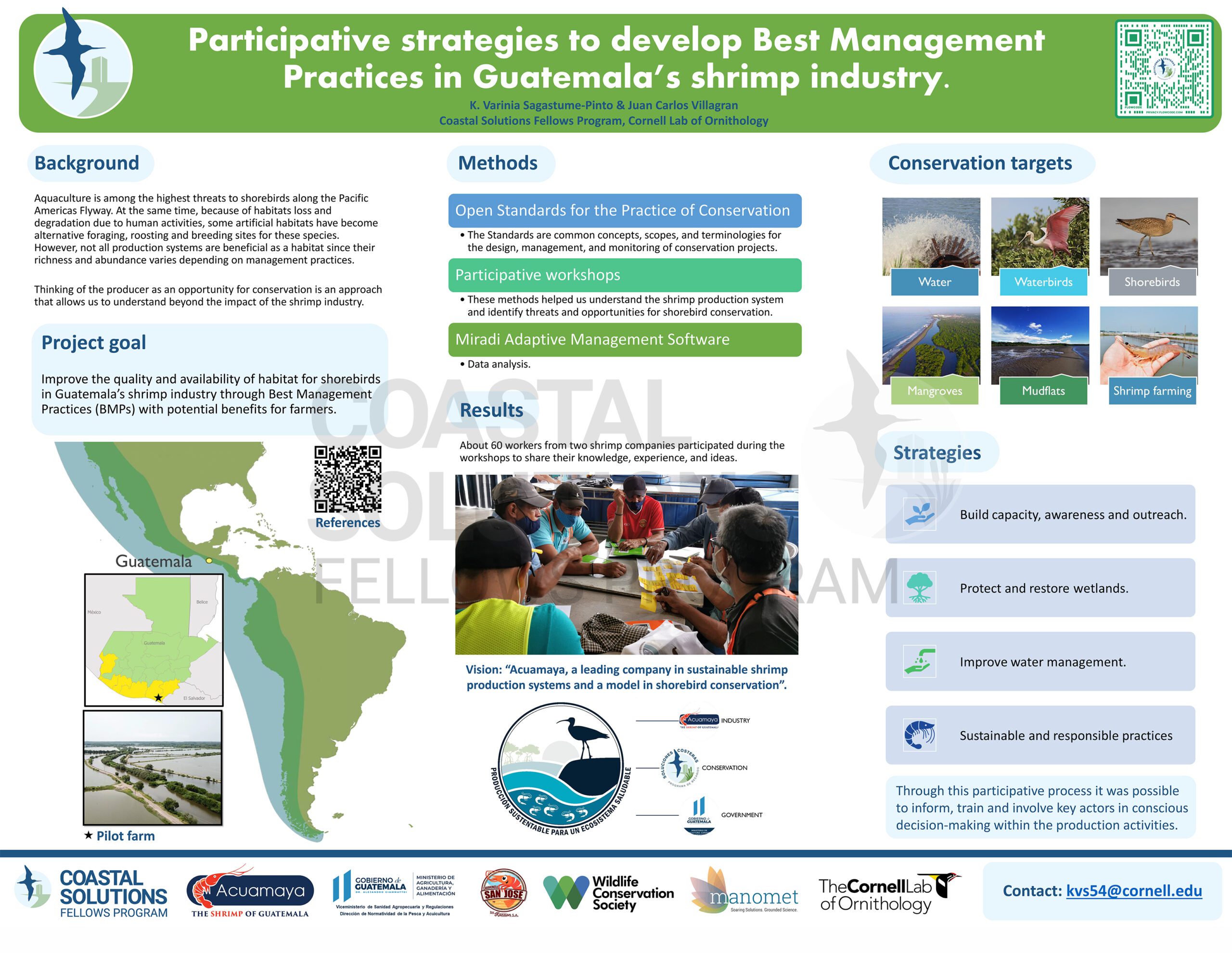
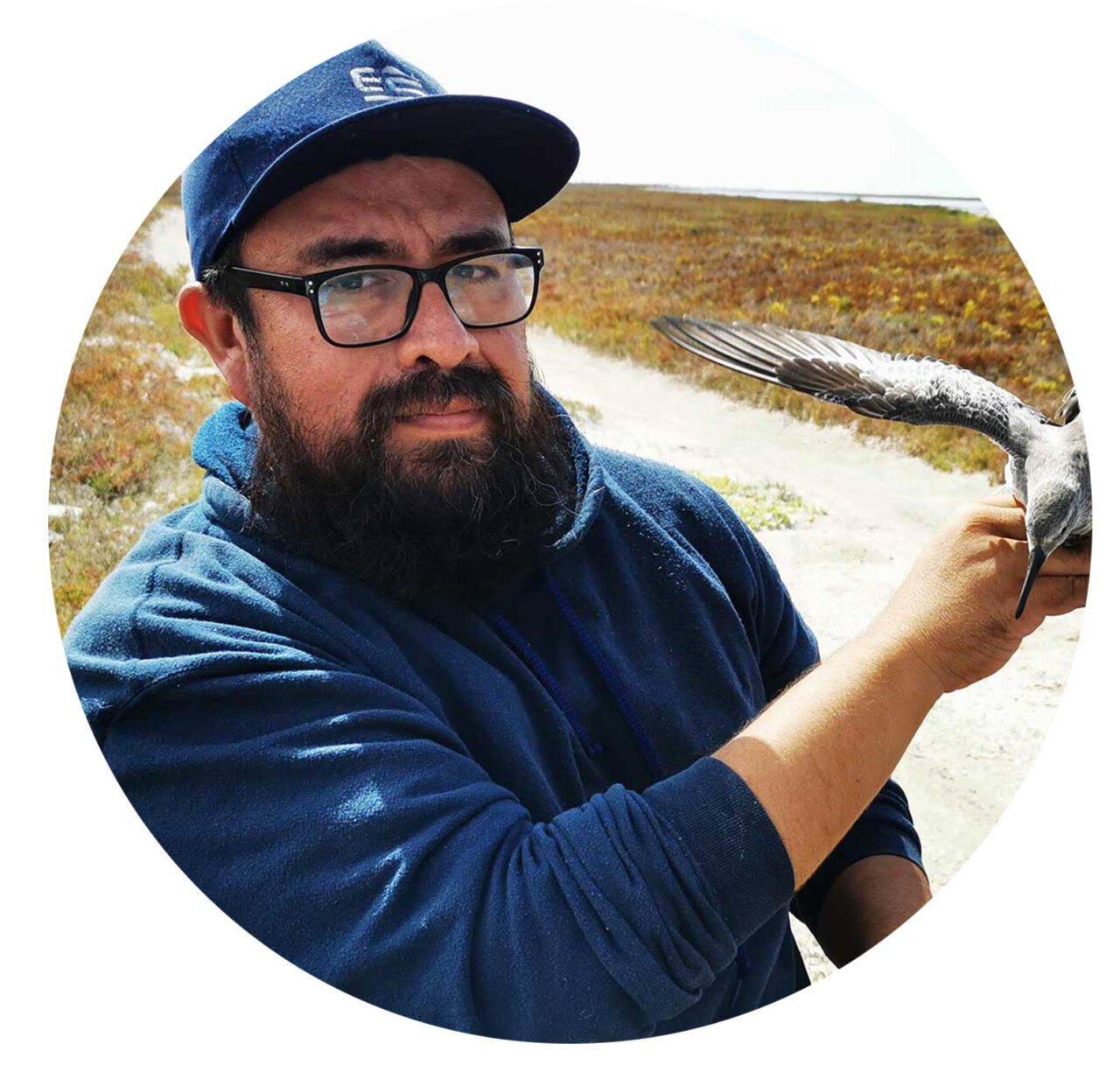
Victor Ayala
Fellow CSF 2022 / México
voa5@cornell.edu
Conservation and management strategy for two complementary wetlands in Ensenada de La Paz for shorebirds
The wetland of Ensenada de La Paz represents a priority site for the conservation of shorebirds on the Pacific Flyway. Up to 20,000 shorebirds use the wetland as feeding and roosting areas, and it has been recognized by different instances for its importance. In the area we can find a mosaic of habitats that include natural wetlands and an artificial wetland, the presence of the latter increases the diversity of resources available to shorebirds and complementary resources to those used in the natural wetland. Despite its importance, the growth of the urban sprawl in the city of La Paz has caused the modification, reduction and degradation of these wetlands and unfortunately their protection is not officially guaranteed. Therefore, the main goal of the project is to ensure the conservation of a mosaic of suitable habitats for shorebirds in the Ensenada de La Paz. Our line of action is addressing the problem from three fronts: (1) We are carrying out actions aimed at the legal protection of both sites, at different levels: local, national and international, in order to protect the wetland assemblage with different recognitions for its ecological importance for birds; (2) We carried out actions for an active management of the artificial wetland, to date an important achievement was to guarantee the water supply to the artificial wetland and we hope to be able to carry out an active management that allows generating a suitable habitat for the different communities of birds and also we are generating infrastructure that allows the development of research, ecotourism and environmental education activities; and finally (3) we are carrying out the shorebird monitoring program of the Ensenada de La Paz. All of our partners are working to achieve the protection and conservation of these wetlands.
Victor presented his poster to a very important group of friends of the Coastal Solutions Program while on a tour of the lagoons of the ‘Ecoparque de la Juventud’, in La Paz, Baja California Sur. Birdwatching and learning about the restoration of these wetlands thanks to Victor’s Coastal Solutions project.
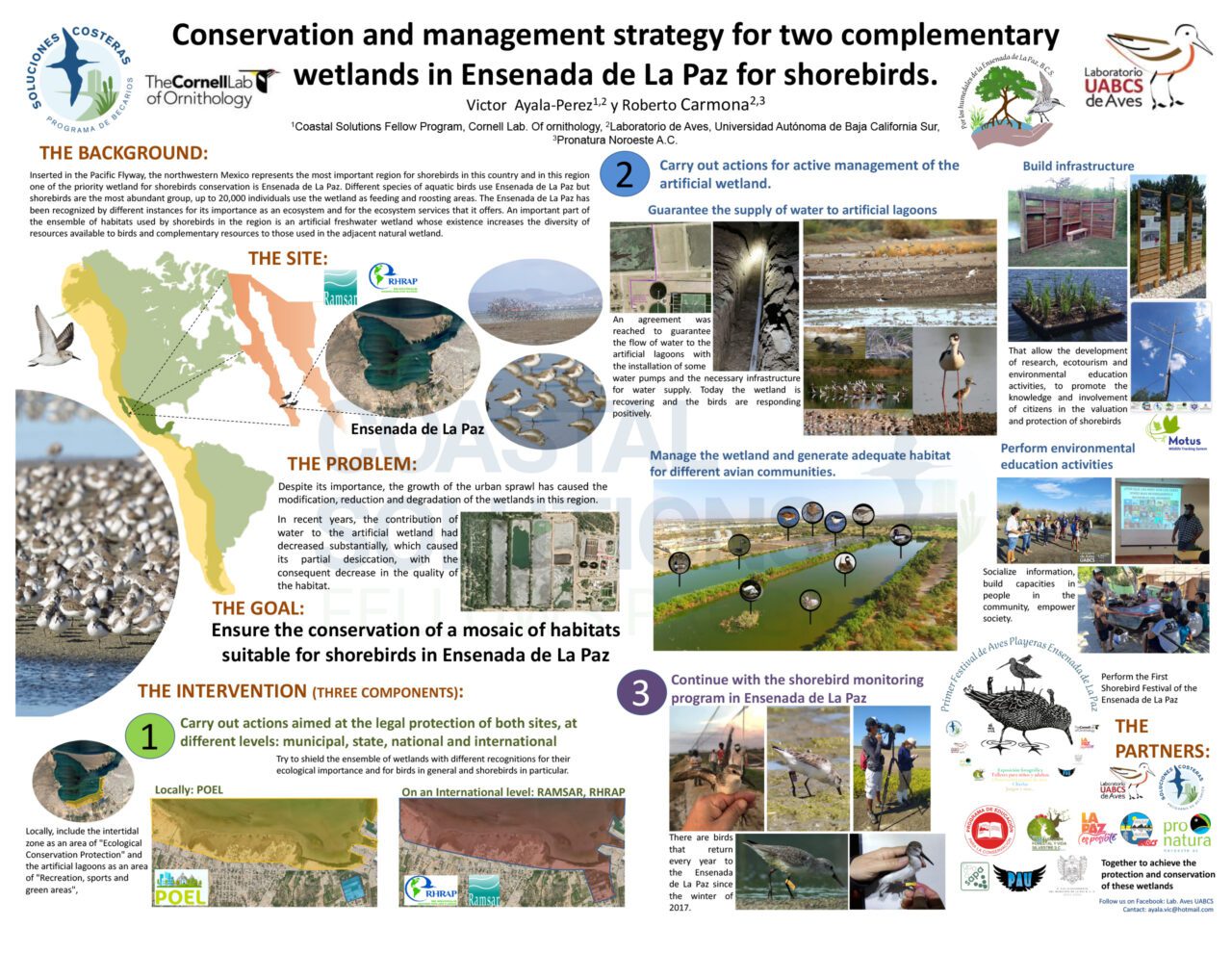

Jorge Enrique Parra
Fellow CSF 2022 / Colombia
jep367@cornell.edu
Marine protected areas & nature-based solutions compatible in protecting shorebird habitad in the pacific coast of Colombia
Increasing marine protected area (MPA) networks of important shorebird habitat is an urgent need to halt the dramatic loss of wetland ecosystems. Main threats to coastal ecosystems and shorebird habitats are related to human activities, including habitat loss and degradation. In Colombia, the current causes of mangrove loss are the establishment of coconut palm plantations and the expansion of human settlements. However, the development of infrastructures such as seaports and highways and the effects of climate change will further threaten the conversion of tidal wetlands in the coming years. The establishment of new protected areas and their effective management can effectively reduce these threats by establishing limits to the development of certain areas and promoting the sustainable use of natural resources. The establishment of MPAs also fits the definition of Nature-based Solutions (NbS), as an “action to protect, sustainably manage and restore natural or modified ecosystems that address societal challenges effectively and adaptively, simultaneously providing human well-being and biodiversity benefits1”. Here, we use the eight criteria of the IUCN global standard to identify NbS in the participatory process conducted to establish two MPAs with sustainable use of natural resources (IUCN Category VI) in the Pacific Coast of Colombia: The San Juan River Delta Ramsar site and Isla Ají in the Naya River Delta, which are part of the Americas Migration Route.
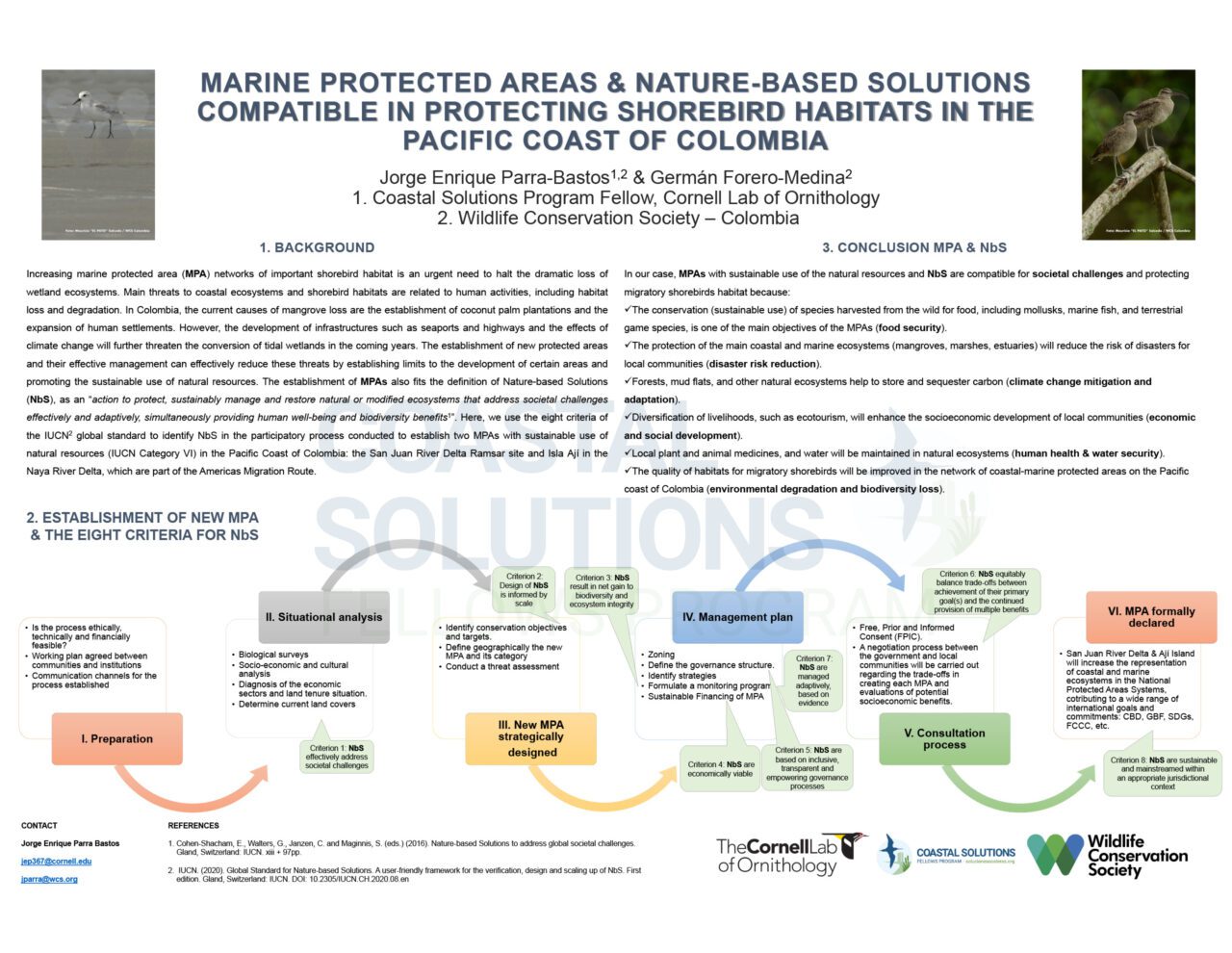

María de los Ángeles Schoenbeck
Fellow CSF 2022 / Guatemala
Assessment of coastal vulnerability in the Pacific of Guatemala
Anthropic development is among the main threats to shorebirds during their migration route. In the Pacific coast of Guatemala, this threat is affecting the mangroves of the Monterrico-Hawaii corridor due to the development of economic activities like, the advancement of the agricultural frontier. Previously, researchers have reported 20 species of shorebirds in the area, including Charadrius nivosus “near threatened” according to the IUCN Red List and listed in the Endangered Species Act under the U.S. Shorebird Conservation Plan, where thirteen additional species are in different categories of concern. For this reason, this project is working to create “Resilient Ecosystems in Harmony with Sustainable Development and Shorebirds”. To achieve this, we are evaluating the area’s coastal vulnerability to climate change by generating a historical database for each variable: precipitation patterns, oceanographic variables, sea level rise, and changes in vegetation cover. This information is obtained from government databases, satellite images, and field data. In addition, we are identifying areas of siltation, and measuring water columns within the area. This information will be combined with the distribution of shore species in the area in order to select priority habitats to conserve and implement intervention and adaptation actions, and will also be input for the models to be developed. Subsequently, inclusive strategies will be designed and implemented with different stakeholders under a Nature-Based Solutions (NbS) approach that will allow the development of governance processes. In addition, a pilot plan for ecological restoration of the mangrove ecosystem is starting out in priority sites that contribute to increasing the hydrological connectivity of the ecosystem.
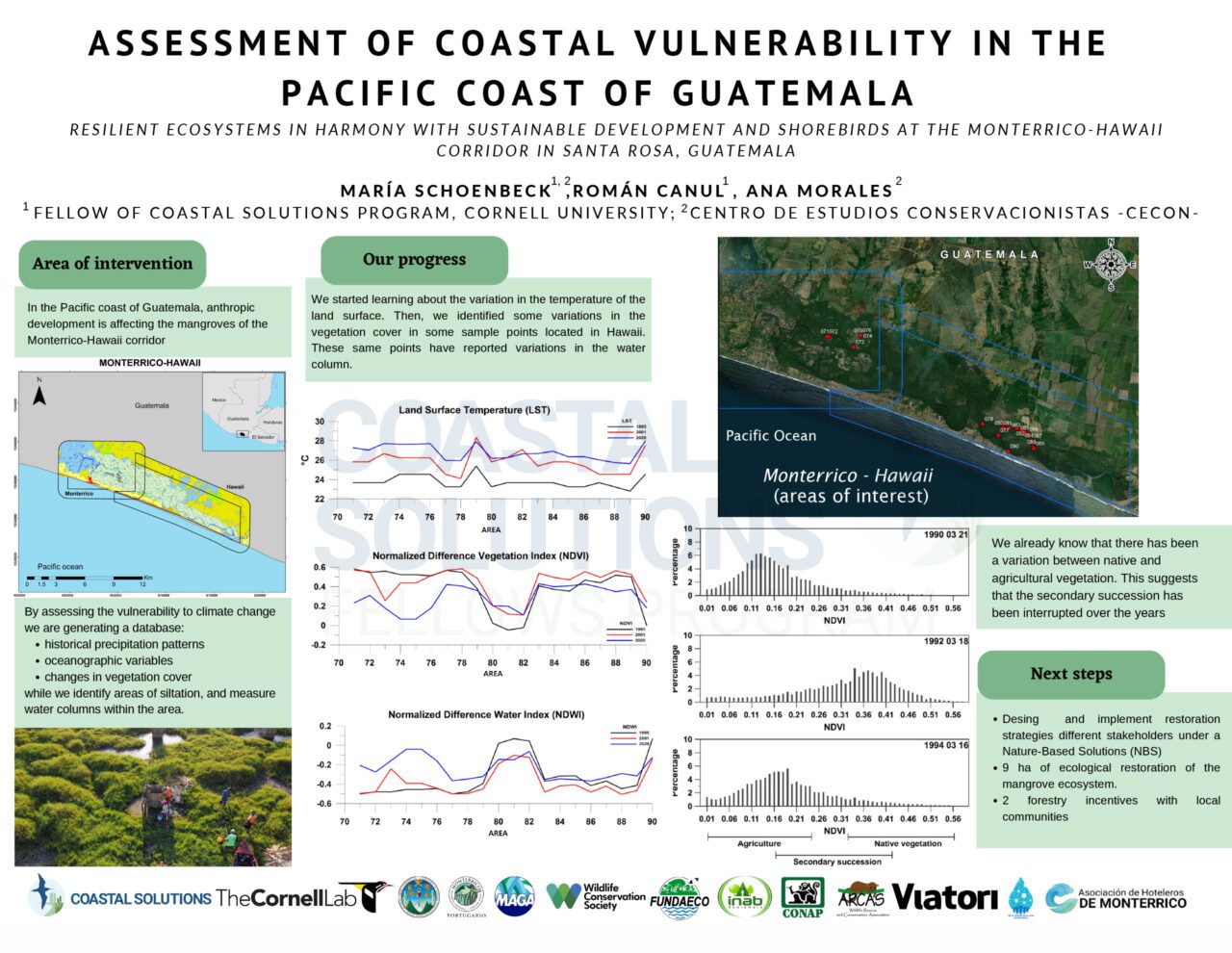

Manuela Erazo
Fellow CSF 2020 / Chile
Participatory landscape planning for the protection of shorebirds in the Tubul-Raqui Wetlands, Chile
Tubul-Raqui, in the Biobío region of Chile, is one of the largest coastal wetlands in the central-southern part of the country. It is a site of global importance in the Pacific Flyway, due to its abundance and richness of shorebirds. In 2010, the area suffered a catastrophic earthquake and tsunami, which drastically changed the hydrological conditions of the wetland, reshaping the social dynamics that occurred in this ecosystem and activating a series of unsustainable practices. This, together with other threats, such as the absence of an instrument for its formal protection, makes it urgent to design and implement an innovative conservation model for the area. The focus of this project is to address the wetland’s conservation problems through three main lines of action: 1) promoting the creation of a Nature Sanctuary to protect the site, 2) establishing a participatory governance model, and 3) promoting the reconnection between the local community and the wetland, focusing on the conservation of shorebirds and their critical feeding and resting areas. In July 2022, Tubul Raqui was officially declared a Nature Sanctuary, a recognised means of protection under Chilean legislation, helping to protect 935,4 hectares of important habitat for migratory shorebirds and rebuild the local community through new means of production and governance.
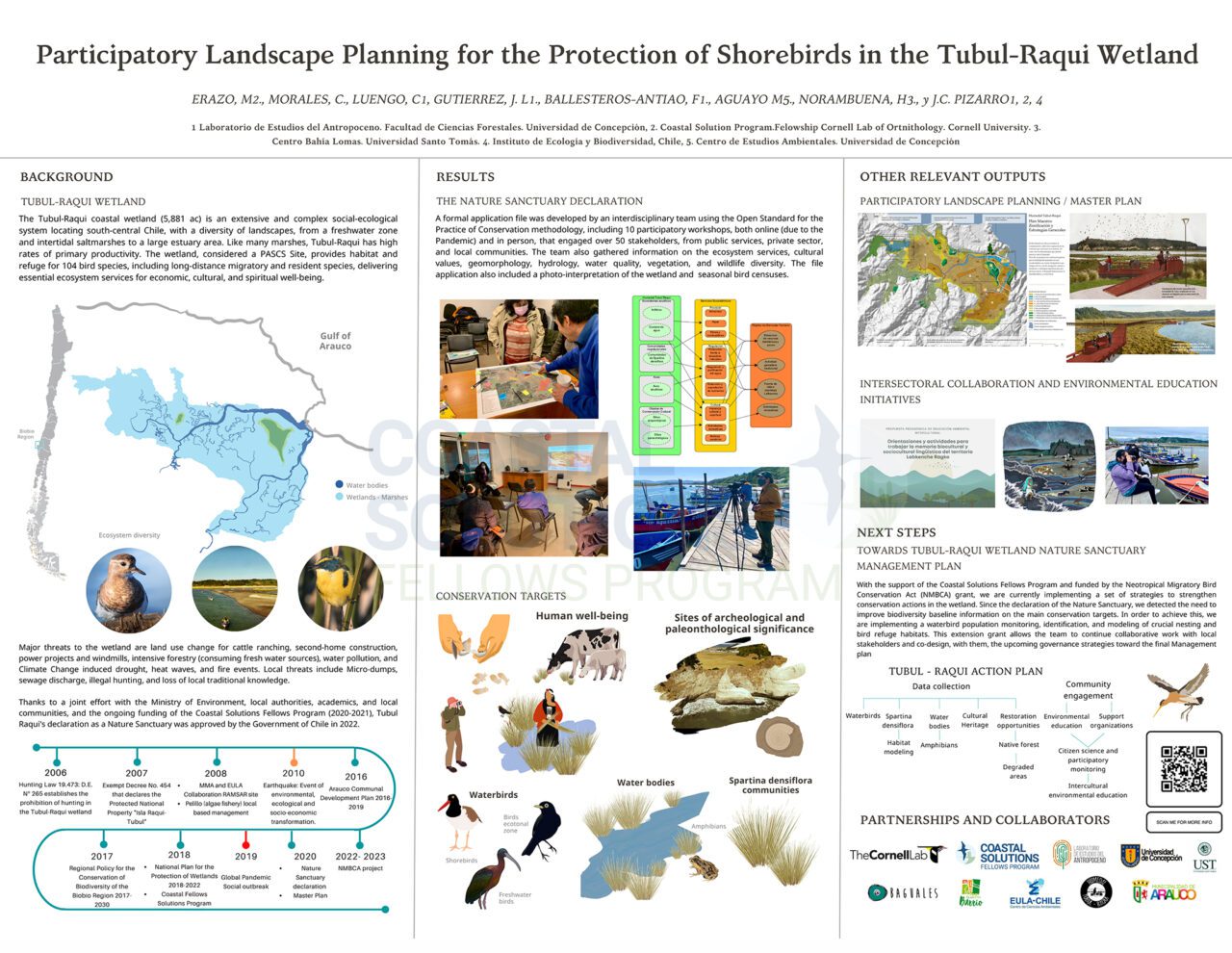
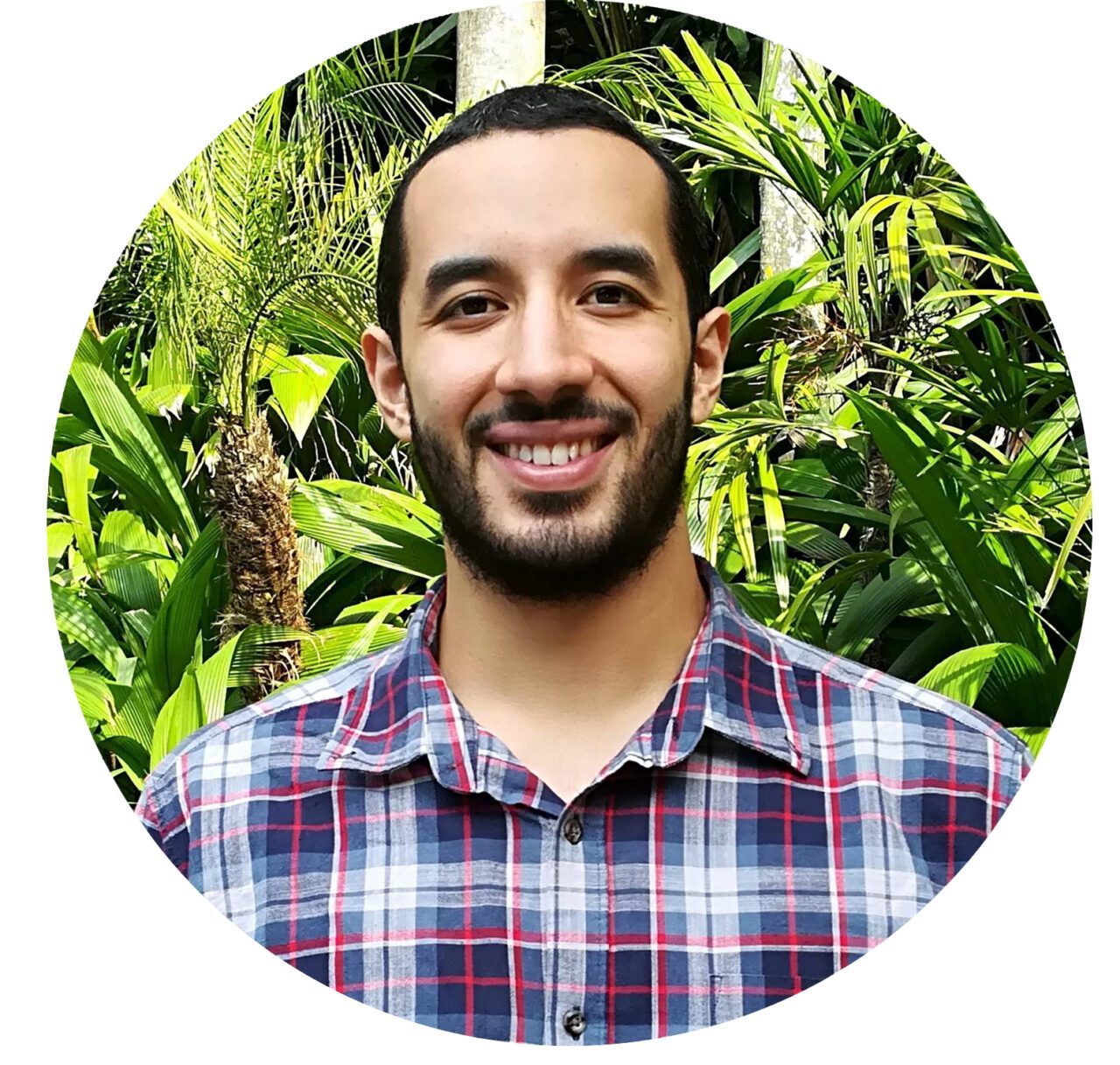
Johann Delgado
Fellow CSF 2019 / Colombia
Turbulence Intensity Peak in a Partially Vegetated Open Channel Flow – Mangroves
The ideas for this research came after several visits and field campaigns working on Punta Soldado Island, Colombia, in 2019 as part of the Coastal Solutions Fellowship Program. This work inspired us to study the physical dynamics of the coastal ecosystems. The presented research is part of the first author’s PhD studies in the Environmental Fluid Mechanics Group at Cornell University. Conservation and restoration of mangrove forests is a promising approach to climate-change mitigation and adaptation in coastal areas. Mangroves are known as “champions” of sequestering soil carbon, about 50 times more effective than tropical forests (McLeod et al., 2011). Human actions like deforestation, can create new channels with relatively high-velocity flows due to a significant reduction in drag forces. Hence, these flows can enhance sediment transport and remove soil carbon from the channels. Paradoxically, the presence of these channels contributes to a reduction of flow velocities within the adjacent forest and potentially facilitates sedimentation. In this work, we conduct experiments using cylinder arrays to represent mangrove roots and the drag effect these roots exert on the flow. Test were run in a recirculating flume (8 m x 0.61 m x 0.6 m) at the DeFrees Hydraulics Lab at Cornell University. Still water level was 0.11 m. Incident velocity was fixed at 0.23 m/s. The cylinders diameter was 0.0126 m, the average spacing between cylinders was 0.056 m, and the solid fraction was 0.04. Results show flow in the unvegetated region accelerates linearly and reaches mean streamwise velocities (U) over two times the incident velocity. The lateral velocity is ‘relatively high’ ( about 0.1U) at the leading edge of the vegetation, but with a rapid decay within the vegetation. A strong mass and turbulent kinetic energy transfer from the vegetated area into the main channel was observed. Spatial data suggest the formation of secondary flows in the main channel that contribute to the redistribution of momentum and mass from the bottom and the vegetated region to the free surface. These experiments helped to obtain a better understanding of the impact of channelization of mangrove forests and prevent irreversible impacts.
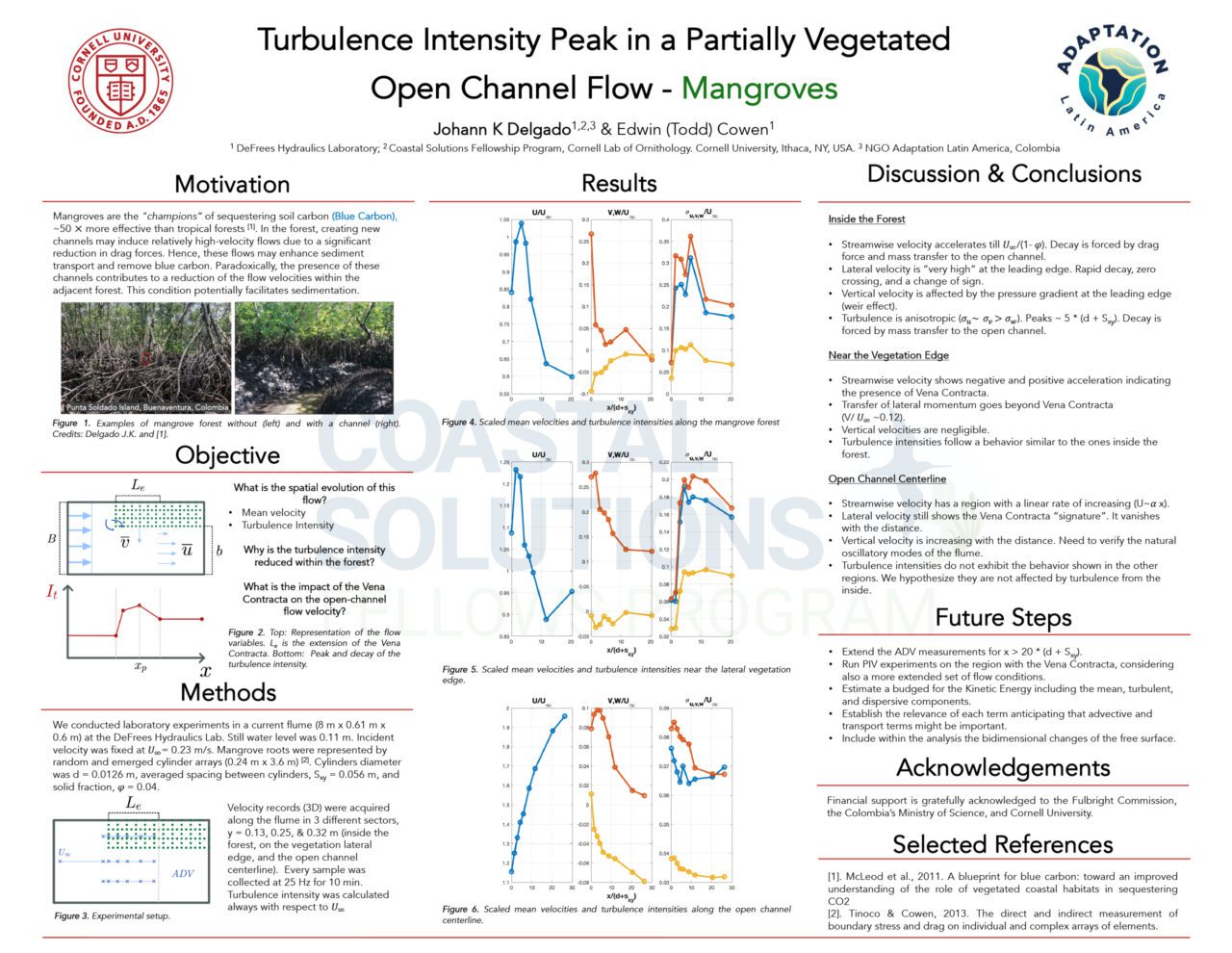
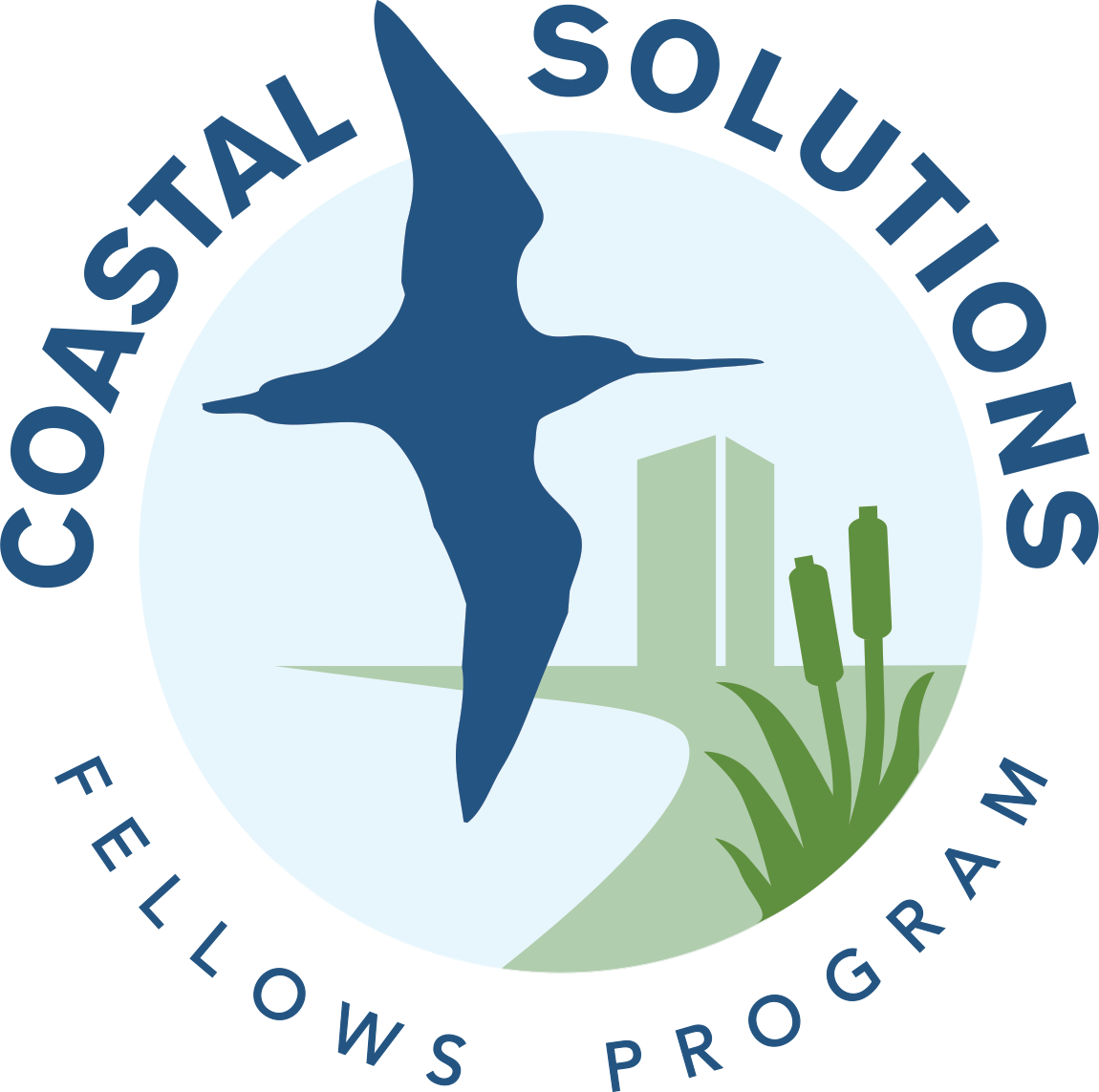
The Coastal Solutions Fellows Program builds and supports an international community to design and implement solutions that address coastal challenges across the Pacific Americas Flyway. Our main goal is to conserve coastal habitats and shorebird populations by building the knowledge, resources, and skills of Latin American professionals, and by fostering collaborations among multiple disciplines and sectors.
